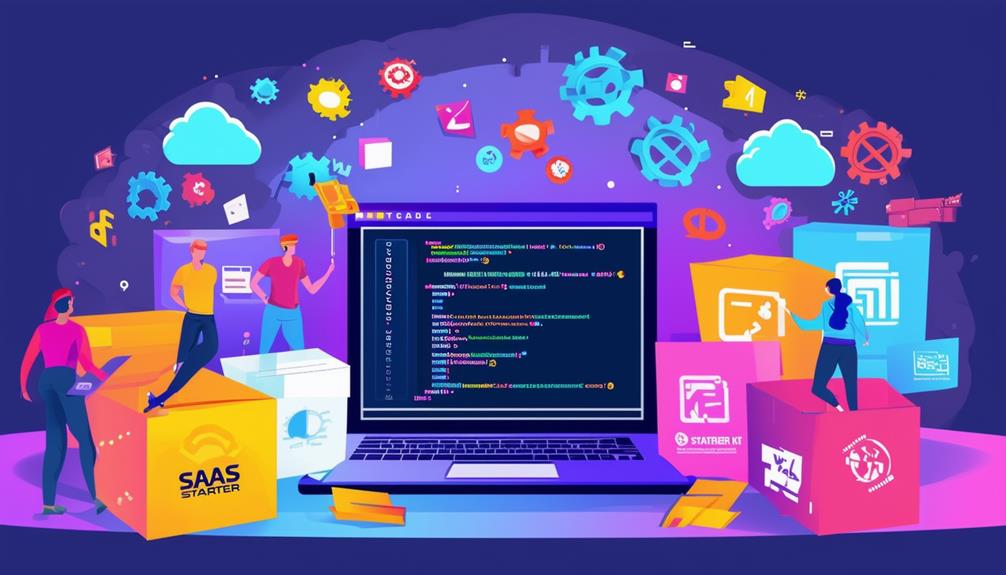When you’re looking to launch a SaaS product quickly, implementing a boilerplate can be a game-changer. You’ll save countless hours by starting with a pre-built foundation that includes essential features and best practices. But how do you choose the right boilerplate and tailor it to your specific needs? It’s not just about picking a popular option; you need to take into account your tech stack, scalability requirements, and target market. The process involves careful evaluation and customization, and there are several key steps you’ll need to follow to guarantee success. Let’s explore how you can leverage SaaS boilerplates effectively and avoid common pitfalls along the way.
Understanding SaaS Boilerplates
SaaS boilerplates are pre-built templates that provide a solid foundation for developing Software as a Service applications, saving you time and effort in the initial setup process. These ready-made frameworks come equipped with essential components, such as user authentication, database integration, and basic UI elements, allowing you to focus on building your unique features.
When you’re implementing a SaaS boilerplate, you’ll typically find a structured directory layout, pre-configured development environments, and standardized coding practices. This consistency guarantees that your project remains organized and scalable as it grows. Many boilerplates also include built-in security measures, helping you protect your users’ data from the start.
Choosing the right boilerplate depends on your tech stack preferences and project requirements. Popular options include Node.js-based boilerplates for full-stack JavaScript development, Django for Python enthusiasts, or Rails for Ruby developers. Each offers different features and trade-offs, so it’s vital to evaluate your needs before selecting one.
Benefits of Using Boilerplates
Now that you understand what SaaS boilerplates are, let’s explore the compelling advantages they offer to developers and businesses alike.
Boilerplates greatly accelerate development time, often reducing project timelines by 30-50%. You’ll save countless hours on repetitive tasks, allowing you to focus on core features and unique selling points.
Cost-efficiency is another key benefit. By leveraging pre-built components, you’ll minimize resource allocation and decrease overall development costs by up to 40%. This efficiency extends to maintenance, as boilerplates often include best practices for scalability and security.
You’ll also enjoy improved code quality and consistency. Boilerplates typically incorporate industry-standard architectures and design patterns, ensuring your project starts on a solid foundation. This standardization facilitates easier onboarding for new team members and smoother collaboration.
Moreover, boilerplates often come with built-in integrations for essential services like authentication, payment processing, and analytics. This saves you time on configuration and reduces potential integration headaches.
Lastly, using boilerplates allows for rapid prototyping and iteration. You can quickly deploy MVPs, gather user feedback, and make data-driven decisions to refine your SaaS product, giving you a competitive edge in the market.
Popular SaaS Boilerplate Options
Several popular boilerplate options have emerged to streamline your SaaS development process, each offering unique features and advantages.
Let’s explore some of the top choices you can consider for your project.
First, there’s Saas Pegasus, a Django-based boilerplate that’s gained traction for its robust feature set and excellent documentation. It’s ideal if you’re looking for a Python-centric solution with built-in subscription management and user authentication.
Next, you’ll find Bullet Train, a Ruby on Rails boilerplate that’s perfect for rapid prototyping. It comes with a suite of pre-built features like team management and two-factor authentication, saving you significant development time.
For those preferring JavaScript, Divjoy offers a React-based boilerplate with a modular approach. You can customize your tech stack, choosing from various backend options and UI libraries.
If you’re targeting enterprise clients, consider SaaS Boilerplate by Cruip. It’s built with Next.js and focuses on delivering a polished, professional look out of the box.
Lastly, there’s Laravel Spark, a PHP-based option that excels in creating subscription-based SaaS applications quickly. It’s particularly useful if you’re already familiar with the Laravel ecosystem.
Choosing the Right Boilerplate
Selecting the ideal boilerplate for your SaaS project hinges on several key factors that align with your specific needs and goals. To make the right choice, you’ll need to take into account your team’s technical expertise, the project’s scalability requirements, and your target market.
First, assess your team’s proficiency in the programming languages and frameworks used by different boilerplates. If you’re comfortable with React and Node.js, a MERN stack boilerplate might be ideal. For Python enthusiasts, a Django-based option could be more suitable.
Next, evaluate the scalability features of each boilerplate. Look for options that offer robust database integration, caching mechanisms, and API support. If you’re planning for rapid growth, prioritize boilerplates with built-in load balancing and containerization capabilities.
Examine the specific features your SaaS product requires. Some boilerplates come pre-configured with authentication systems, payment gateways, or analytics tools. Choosing one that aligns with your core functionalities can save significant development time.
Lastly, don’t overlook community support and documentation. A well-maintained boilerplate with active contributors and thorough guides can be invaluable for troubleshooting and future updates.
Customizing Your Boilerplate
Once you’ve chosen your ideal boilerplate, it’s time to tailor it to your specific SaaS needs. Start by reviewing the boilerplate’s structure and identifying areas that require customization. Focus on key components such as user authentication, database schemas, and API endpoints.
Next, modify the UI/UX elements to align with your brand identity. Update color schemes, typography, and logos to create a cohesive look. Don’t forget to adjust the navigation and layout to suit your SaaS functionality.
Integrate your chosen tech stack by replacing or adding libraries and frameworks. Guarantee compatibility between different components and resolve any conflicts that may arise. Update configuration files to reflect your project’s requirements, including environment variables and deployment settings.
Customize the database models to match your data structure. Add or remove fields, create relationships between entities, and implement necessary validations. Adjust API routes and controllers to handle your specific business logic and data flow.
Best Practices for Implementation
Now that you’ve customized your boilerplate, it’s time to focus on implementing it effectively by following industry-proven best practices.
Start by establishing a clear version control strategy using Git or a similar system. This guarantees you can track changes and collaborate seamlessly with your team.
Next, implement a robust CI/CD pipeline to automate testing and deployment processes. This reduces errors and speeds up your development cycle.
Don’t forget to set up extensive logging and monitoring tools to catch issues early and maintain peak performance.
Security should be a top priority. Regularly update dependencies, implement proper authentication and authorization mechanisms, and conduct security audits.
Additionally, enhance your database queries and implement caching strategies to improve performance as your user base grows.
Document your code thoroughly and maintain up-to-date API documentation. This will make it easier for new developers to onboard and for you to maintain the project long-term.
Common Pitfalls to Avoid
While implementing SaaS boilerplates can streamline your development process, you’ll need to watch out for several common pitfalls that could derail your project. One major trap is over-reliance on the boilerplate’s structure without customizing it to fit your specific needs. This can lead to bloated code and unnecessary features that slow down your application.
Another pitfall is neglecting to update the boilerplate components regularly. As technology evolves, outdated elements can introduce security vulnerabilities and compatibility issues. You should also be cautious of poor documentation practices. Failing to document customizations and modifications can make future maintenance and onboarding of new team members challenging.
Don’t fall into the trap of ignoring scalability concerns. While boilerplates often provide a solid starting point, they may not always be optimized for large-scale applications. Be prepared to refactor and optimize as your user base grows.
Lastly, avoid the temptation to use multiple boilerplates without proper integration. This can result in conflicting dependencies and inconsistent coding styles. Instead, choose a single, thorough boilerplate or carefully curate components from different sources to guarantee a cohesive codebase.
To Wrap Up
You’ve now got the tools to implement SaaS boilerplates for rapid development.
By choosing the right template, customizing it to your needs, and following best practices, you’ll save time and resources.
Remember to prioritize security, performance, and documentation throughout the process.
Don’t forget to avoid common pitfalls and keep your team aligned.
With these strategies, you’re well-equipped to launch your SaaS product quickly and efficiently.
Start building today!






